Many times when I walk along a familiar trail I begin to question whether I will see anything unusual that trip or, even more unlikely, anything willing to pose for photographs. In spring and summer I can at least hope for a new flower or plant or a new view of an old favourite. (I like plants because they usually stay still when I try to photograph them, although sometimes a spring breeze will tease them into dancing in and out of focus.) So when I was quietly crunching along the fine gravel of the river road last week, I was delighted when I spotted a wren and doubly excited when it actually stayed within camera range while I edged past so I could turn and have the sunlight behind me and the lens.
The Many Wrens of Riverwood Conservancy, Mississauga
I cheerfully admit I am not great at identifying wrens in the field. They are small. They are fast. And they have very unique songs that I seem unable to memorize. So I always try to photograph them and then I can look them up later and get the opinion of experts.
This time, however, I finally had a Wren who wanted me to notice all of its features. It stayed still! It sang—which would make identification deadly simple for anyone with a better memory than me—and it was very close so even without binoculars I could see its bill, face, and body colouring.
This busy home inspector was a House Wren. Usually they migrate south for the winter.
I have also seen Carolina Wrens here at Riverwood all year round.
Winter Wrens also flit through on migration. I have never taken a good photo of one here (well, anywhere! Yet.) but I have seen them.
And according to Dan Salisbury, co-leader of one of the spring bird walks, sometimes Sedge Wrens pass through. I have never knowingly seen one but I will certainly keep trying!
House Wrens Love Nest Boxes
I have been watching for the House Wrens to return at Riverwood. The park staff put up nesting boxes in various locations and one of the ones along the board walk was used in the summer of 2014.
In fact, I was sure I was looking at a House Wren not far from one of the nest boxes the same morning I met the one whose photos grace this report. When I got home and zoomed in the photos, I discovered it was actually a Northern Waterthrush.
Oops! If you ever meet me walking, don’t trust my field bird id skills!
The real House Wren I met was investigating an old woodpecker hole. It’s quite possible it was considering whether it would make a good nest hole. Judging by how large the entrance hole is compared to the bird, however, I’m not sure it will want to use this site. (You can be sure I’ll be checking for signs of occupancy over the next weeks though.)
Another Wren Setting Up House
A few days later while down closer to the Lake, I chanced to meet another House Wren. This one was into home renovations, though. It was carrying nesting materials into a hole in a dead tree top.
What was very amusing, to me not the Wren, was when it brought something stiff that was longer than the diameter of the hole. It tried pushing it in (across the hole) twice before the material unexpectedly fell from its beak. It watched it fall to the ground with an annoyed expression.
The next piece it brought was also too large, but it was soft and bent when pushed hard against the trunk on either side of the hole so it popped in.
Today, when I was visiting that park again, I checked progress. There were two wrens at the building site!
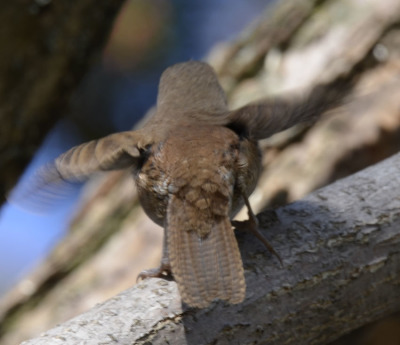
This wren, presumably the male, was fluttering and calling near the nest hole.
One was calling and fluttering its wings in a frenzy of excitement, changing perches but never moving more than inches from the nest hole.
The other kept popping in and out of the hole but not engaging in any, er, activity with the other.
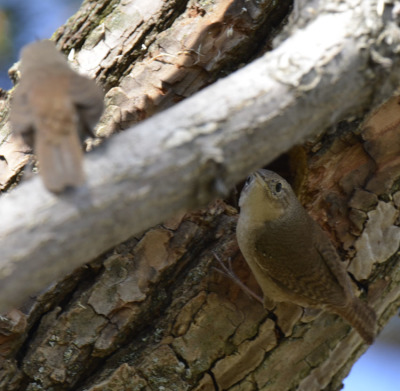
The presumed female is near the nest hole and the male is on the branch nearby.
I wondered if perhaps the male builds the nest and tries to entice a female to join him in using it? When I got home I looked for more info online. Yes! It’s true: AllAboutBirds says that males build nests hoping to persuade a female to mate with him.
The female I saw today didn’t seem convinced that the site was good enough but maybe she’ll agree if the nearby schools are good and the property taxes aren’t too high.

This is the Riverwood House Wren again.
So now I have two possible homes for House Wrens to keep an eye on as the spring progresses. More if I count the next boxes at Riverwood. Hopefully I’ll see signs of hungry chicks inside later this year.
Related Reading
- This House Wren Lives in the Great Ontario Wilderness
- An Early October Ramble through the Rattray
- An Early November Ramble at Riverwood
Join In
Do you have a pair of House Wrens nesting near you? Apparently they will nest in mailboxes and other odd places like coffee cans in garages. Please share your Wren home renovation stories with a comment.

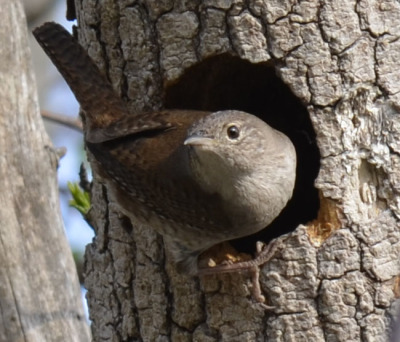
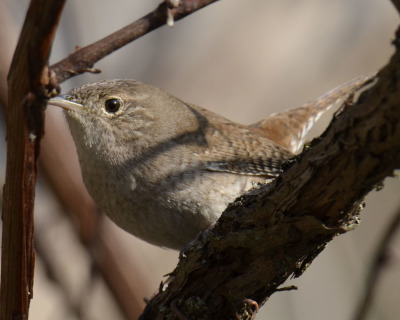


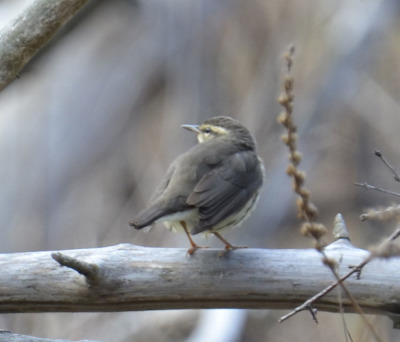

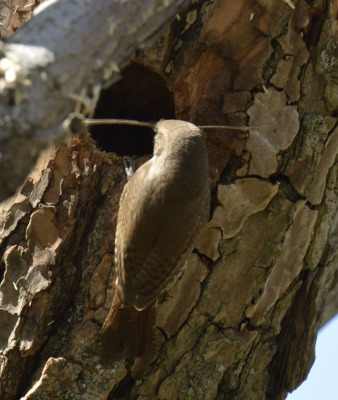
I attached a homemade birdhouse embellished with shells and moss to a branch teepee in my garden. Quiet street in front and wooded area at the side.it was quickly inhabited by a fluttery pair of house wrens. They seem to love the place.can’t figure out why they’re still there after a month tho I’m thrilled to have them as neighbors.when exiting or entering their home they flutter their little wings while perched nearby. Don’t know if these are begging babies or excited adults.
The adults I’ve seen also shiver near their nest site. I think it may be a signal to each other of some kind. The wrens nesting closest to me just hatched their brood a few days ago and now the adults are flitting in and out with mouths full of insects. They usually perch outside the house for a minute first to check if anyone is watching and then dart in. Hopefully you’ll see some babies outside the house soon. Thanks for sharing your experience–and for providing them with a home!